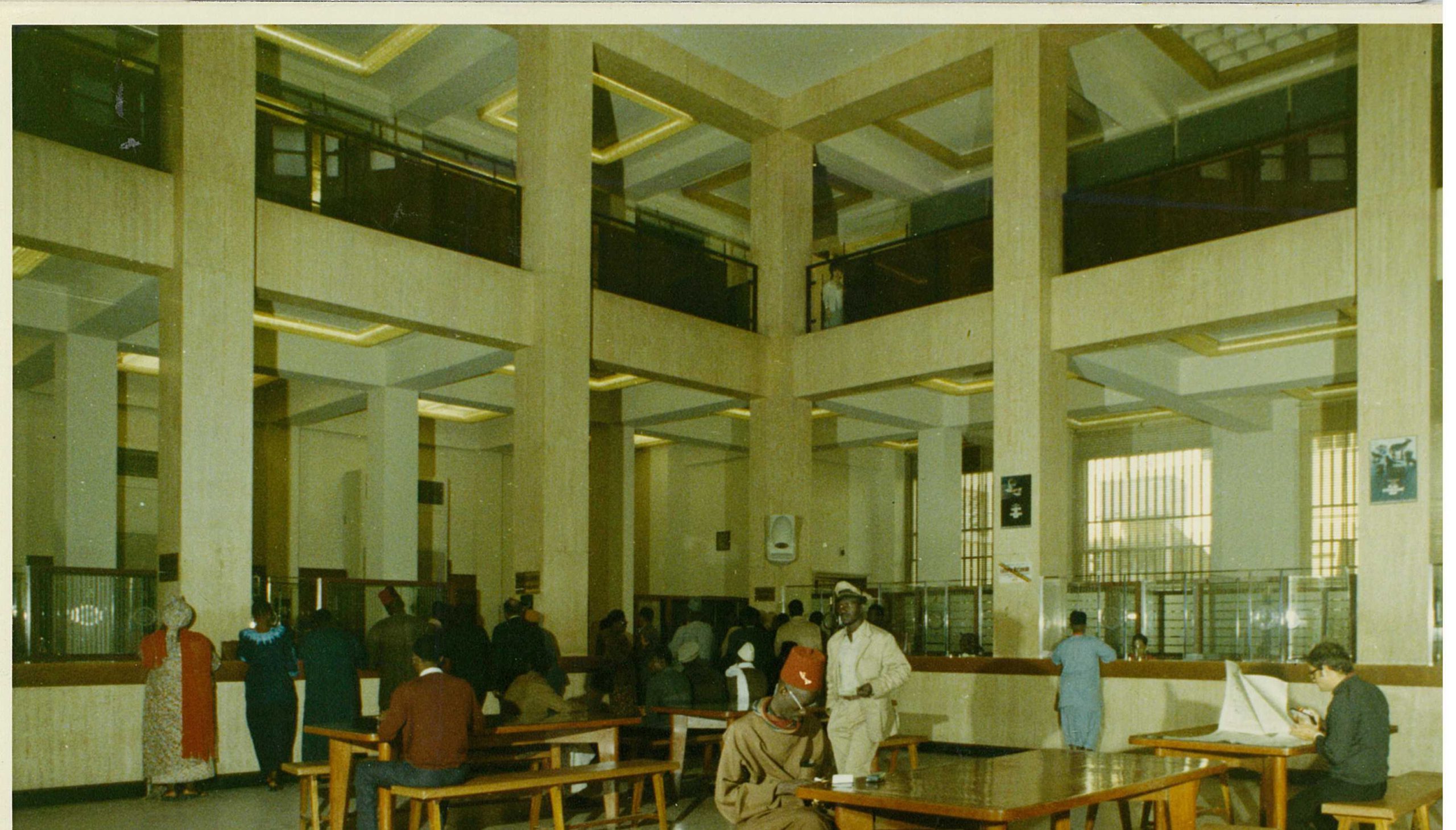BNP Paribas and the expansion of the railway in Marocco in the 1920-1950’s

One of the most modern in Africa nowardays, Morocco’s railway network was developed relatively late, and in a chaotic way.
Since the middle of the 19th century, Morocco faced an era of modernization, and was opening up to European trade, but at the time, there is no railway in the country. Although a narrow-gauge railroad was built after the establishment of the French Protectorate in 1912 and opened to commercial traffic in 1915, travel times were long and connections were slow: it took five days to travel from Casablanca to Oujda.
The creation of a more suitable rail network was therefore a key issue in the reform of the Cherifian state and the commercial development of the territory.
Through a selection of archival documents from the BNP Paribas collections, covering the 1920-1950’s, let us have a glimpse into the development of the Moroccan railroads, in which the BNP Paribas forerunners banks played a strategic role in its financing.
The Compagnie générale du Maroc (CGM), an influential holding company
It all began in 1912 with the creation by the Banque de Paris et des Pays-Bas (BPPB), supported by a group of major French banks, of the Compagnie générale du Maroc (CGM), a holding company that managed the interests of its shareholders in a multitude of companies, with its headquarters in Paris. It is chaired by a BPPB executive, while CNEP (Comptoir national d’escompte de Paris), BFCI (Banque française pour le commerce et l’industrie) and Banque impériale ottomane, all BNP Paribas forerunners banks, and other stakeholder banks are represented on the board.
The company’s portfolio is composed mainly of public works companies and public buildings, railroads, electric lighting, mining and oil exploration, industry and agricultural companies.
The company thus contributes to the development of the country’s economy. Its action is carried out especially through its contacts, its networks and its capacity to mobilize the other banks of the place. By this way, it became a key shareholder in the future operating companies of the Moroccan railway.
Three companies to operate the Moroccan railway system
The main one : the Compagnie des chemins de fer du Maroc (CFM)
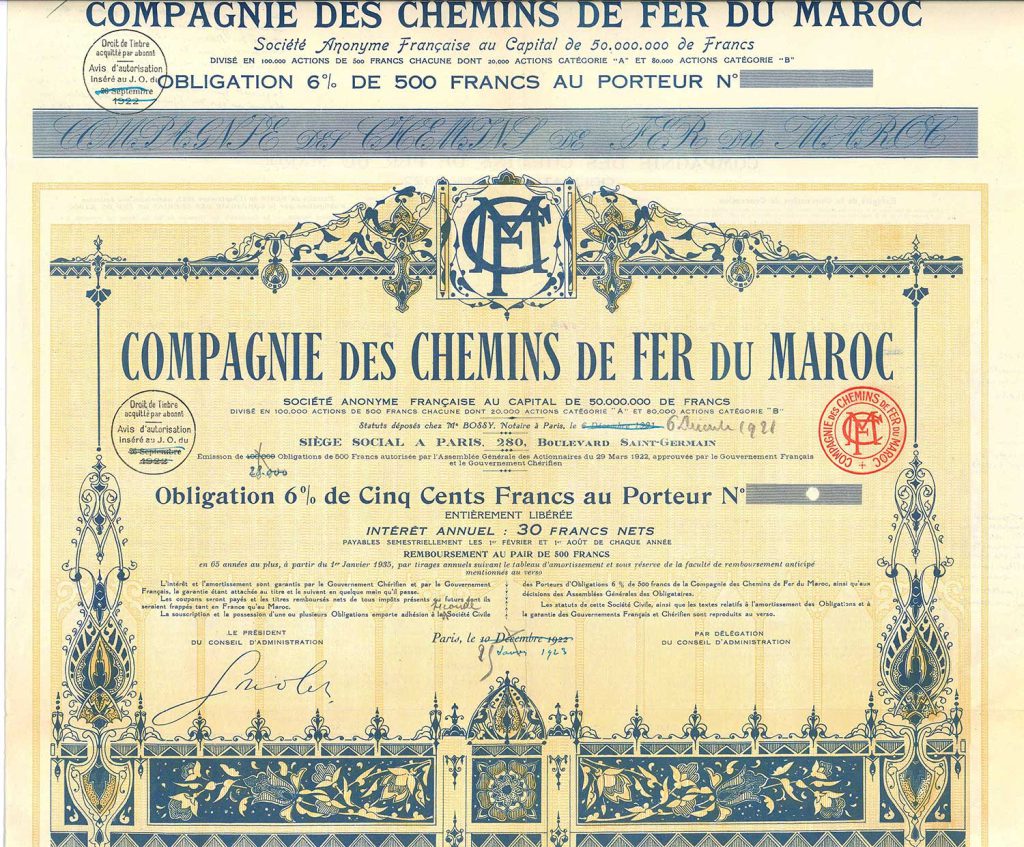
After World War I, on June 29, 1920, a concession was granted to the Compagnie des chemins de fer de Paris à Lyon et à la Méditerranée (PLM), the Compagnie générale du Maroc (which held 33% of the shares) and the Compagnie marocaine: they were granted a network of 945 km to build 6 lines, a network serving the main routes in Morocco, from the Algerian border to Marrakech.
In February 1922, these four concessionaires formed the Compagnie des chemins de fer du Maroc (CFM), a French company housed at the same address as the CGM and administered in Rabat.
The CFM was to lay and operate a normal track, i.e. a European gauge of 1.44 m, which would replace the narrow gauge track where it existed:
- in December 1928, the civil railroad connected Fez to Marrakech – from Fez to Petitjean (Sidi Kacem), the track was that of Tangier-Fez, open on this section since October 1923;
- the CFM line connects to it – since June 1923, and links Rabat via Kenitra;
- the Rabat-Casablanca line, electrified in 1927, went into service in June 1925,
- and the Casablanca-Marrakech line via Settat was completed in December 1928.
This network has a length of 458 km.
In addition, on this last line, there were two branches serving mining areas:
- in Berrechid, the Khourigba-Oued Zem branch completed in June 1925, 120 km electrified;
- at Ben-Guerir, the one to Safi via Louis-Gentil (Youssoufia), 142 km commissioned in May 1933 and belonging to the second network conceded in 1929.
In 1934, the main Marrakech – Casablanca – Rabat – Meknes – Fez – Taza – Oujda line was completed and extended to the Algerian border. In 1955, the Moroccan railway network was 1,856 km long.
The railroad crossed rich agricultural regions (Rharb, Saïs plain), served the major industrial cities, including the Casablanca-Mohammedia agglomeration and the cities of Fez, Tangier, and Kenitra, and transported heavy products.

CFM is also responsible for the technical operation of the railroads of the Compagnie des chemins de fer du Maroc oriental and of the Compagnie franco-espagnole du chemin de fer de Tanger à Fez.
The Compagnie des chemins de fer du Maroc oriental
The installation of the Oujda-Bou Arfa line was not included in the CFM’s project in 1920.
After a difficult gestation period, the Compagnie des chemins de fer du Maroc oriental (CMO) was founded in Rabat in May 1927, in order to build and operate a 349 km line to evacuate manganese from Bou Arfa to Oujda. A subsidiary of the CFM and the Société des mines de Bou Arfa – the CMO, was established in April 1927 for a 50 years period. It was chaired by A. Mange, a director of the CFM and the Paris-Orléans railway, and was a company under Moroccan law. The project was to lay a 1.05 m track.
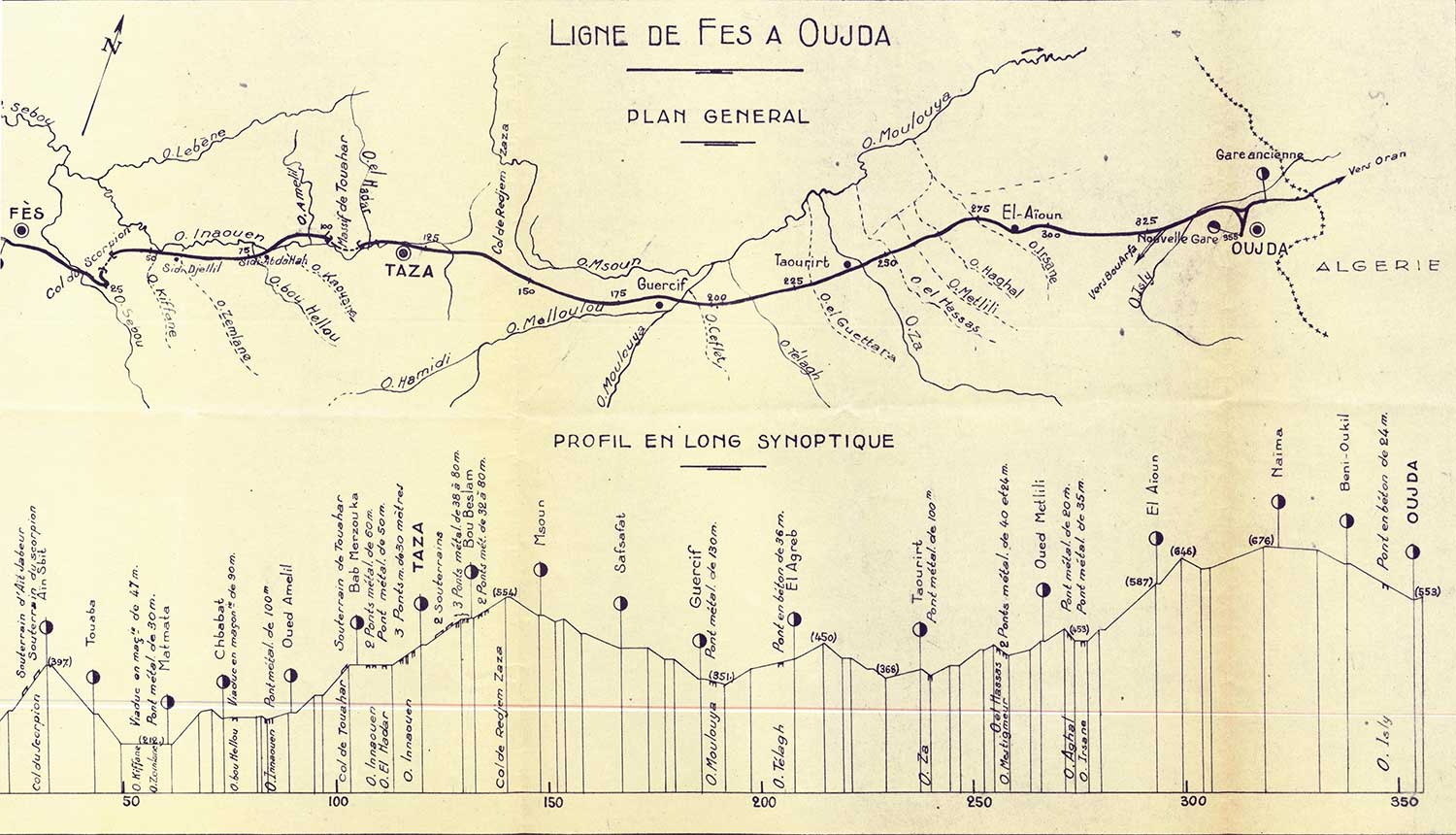
In November 1929, this first network was supplemented by the concession known as the second network, of lesser length, insofar as the part located in eastern Morocco was already included in the general layout of 1920.
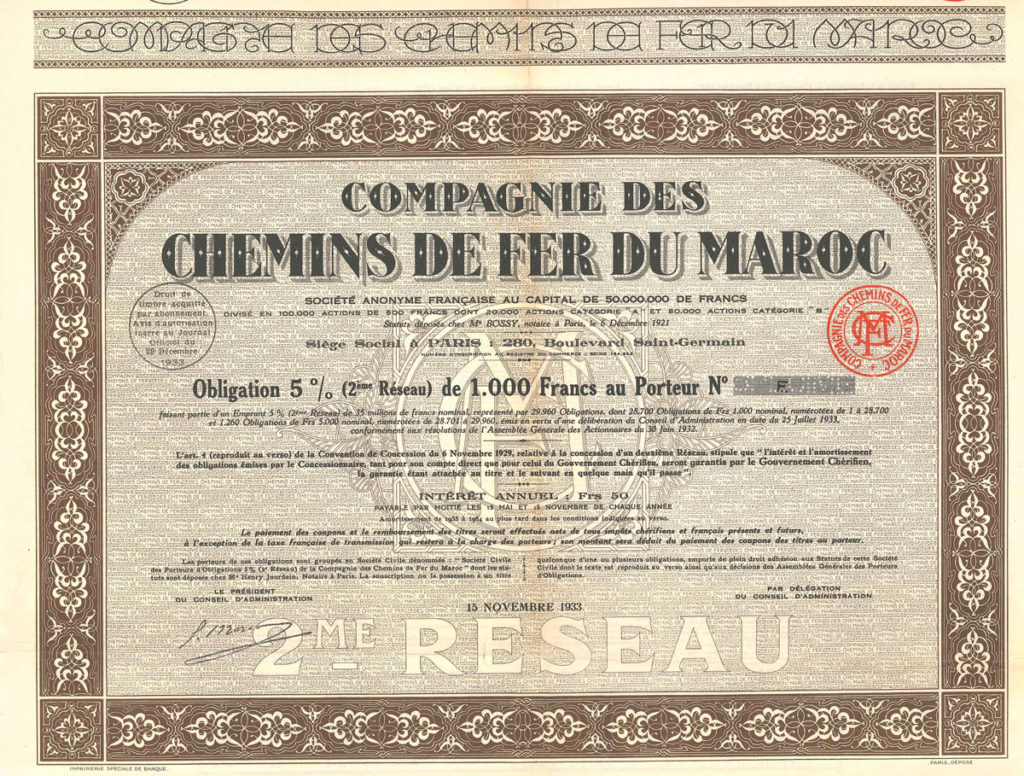
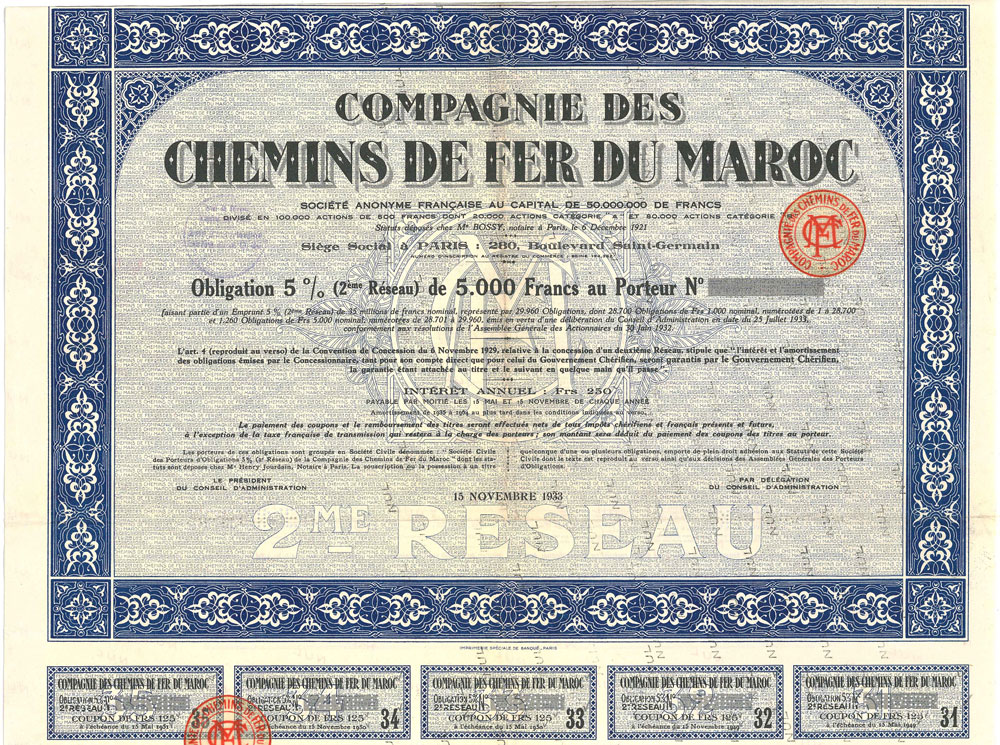
The Tangier-Fez line, the Franco-Spanish railroad
Following the Franco-German agreement of November 4, 1911, which put an end to the Agadir crisis, priority is given to the construction of the Tangier-Fez railroad line before any other public railway construction in Morocco.

A first protocol is signed on November 27, 1912: the future company would have an international character, the capital divided 60% for France and 40% for Spain.
In April 1913, the CGM is appointed by the French government to form the French component of the Tangier-Fez railroad concession company and to subscribe to the French share of its capital. Founded in Meknes in June 1916, the Franco-Spanish company of the Tangier-Fez railroad crossed the Sebou valley, a very fertile region, and served Souk el-Arba and Petitjean.
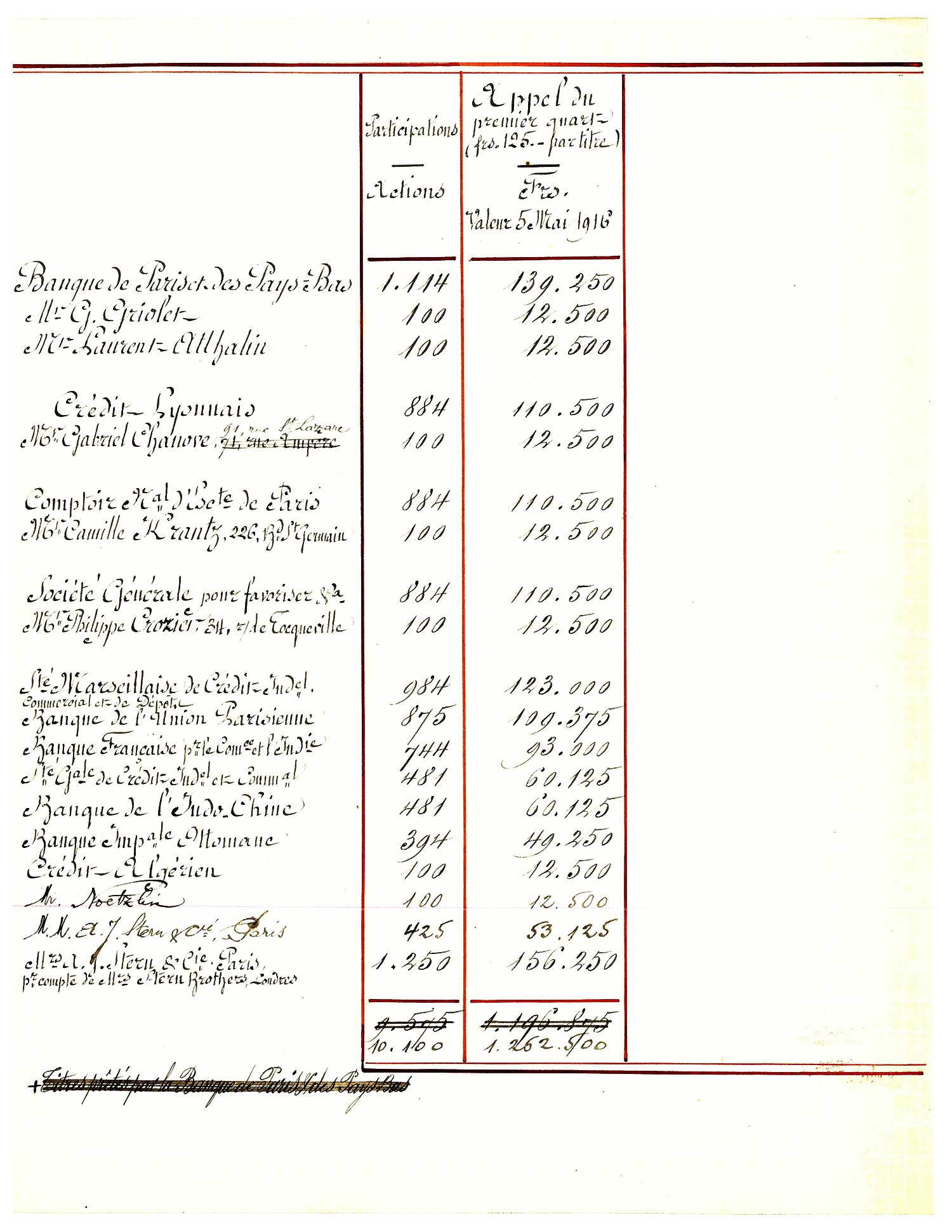
The convention granting the concession of the line is signed on March 18, 1914, after being sanctioned by French and Spanish laws. It is awarded to a consortium formed by the Compagnie Générale du Maroc and the Compañia General Española de Africa. Of the 315 kilometers of the route, 18 km were in the international zone of Tangiers, 93 km in the Spanish zone, and 204 km in the French zone. However, these two companies created the Compagnie franco-spagnole du chemin de fer de Tanger à Fès only in June 26, 1916.

The line was fully completed in 1927, after the opening of the following sections: 111 km from Fez to Sidi Kacem in April 1923 ; 46 km from Sidi Kacem to Mechra Bel Ksiri in August 1925 ; 12 km from Mechra Bal Ksiri to Souq Larb’a al Gharb in July 1926, and 142 km from Souq Larb’a al Gharb to Tangier in July 1927.
The transport of goods, the main vocation of the railroad in Morocco
As early as 1923, the creation of specific mining lines attests to this essential role: serving the “Plateau des Phosphates” and the Gantour deposit, transporting manganese from the High Atlas, loaded at the Marrakech station, towards Casablanca.
Far behind phosphates, all other mining products form still a significant part of rail traffic. Then, the agricultural products, cereals and citrus fruits occupy the third place in the rail tonnage.
Finally, the Moroccan railroads played a role in public transport very early on: they were used for city-to-city links, as well as for long journeys to Tangiers and Oujda or to neighboring countries such as Algeria.
After the country’s independence in 1956, the entire railway network, which was relatively modern and in good condition, was taken over by the Moroccan government, only the Tangier-Fez Company retaining a certain degree of financial autonomy. On January 1, 1963, the Office National des Chemins de Fer (ONCF) is created, a public establishment of industrial and commercial nature.








